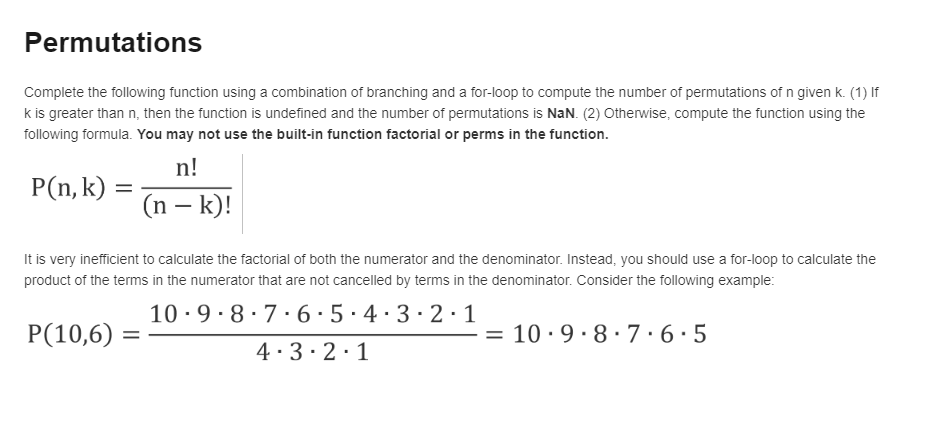he code in is Matlab. This is what I have so far. I"m not sure what to do. function [P] = permutations(n, k) % calculate the number of permutations P P = 1; if k > n P = NaN; else for i = 1:n P = P*i; end end
he code in is Matlab. This is what I have so far. I"m not sure what to do. function [P] = permutations(n, k) % calculate the number of permutations P P = 1; if k > n P = NaN; else for i = 1:n P = P*i; end end
Computer Networking: A Top-Down Approach (7th Edition)
7th Edition
ISBN:9780133594140
Author:James Kurose, Keith Ross
Publisher:James Kurose, Keith Ross
Chapter1: Computer Networks And The Internet
Section: Chapter Questions
Problem R1RQ: What is the difference between a host and an end system? List several different types of end...
Related questions
Question
The code in is Matlab. This is what I have so far. I"m not sure what to do.
function [P] = permutations(n, k)
% calculate the number of permutations P
P = 1;
if k > n
P = NaN;
else
for i = 1:n
P = P*i;
end
end

Transcribed Image Text:Permutations
Complete the following function using a combination of branching and a for-loop to compute the number of permutations of n given k. (1) If
k is greater than n, then the function is undefined and the number of permutations is NaN. (2) Otherwise, compute the function using the
following formula. You may not use the built-in function factorial or perms in the function.
n!
P(n, k) :
(n – k)!
It is very inefficient to calculate the factorial of both the numerator and the denominator. Instead, you should use a for-loop to calculate the
product of the terms in the numerator that are not cancelled by terms in the denominator. Consider the following example:
10 -9· 8·7·6·5·4·3·2·1
P(10,6) =
= 10· 9· 8· 7·6·5
4·3·2·1
Expert Solution
This question has been solved!
Explore an expertly crafted, step-by-step solution for a thorough understanding of key concepts.
Step by step
Solved in 2 steps with 2 images

Recommended textbooks for you

Computer Networking: A Top-Down Approach (7th Edi…
Computer Engineering
ISBN:
9780133594140
Author:
James Kurose, Keith Ross
Publisher:
PEARSON

Computer Organization and Design MIPS Edition, Fi…
Computer Engineering
ISBN:
9780124077263
Author:
David A. Patterson, John L. Hennessy
Publisher:
Elsevier Science

Network+ Guide to Networks (MindTap Course List)
Computer Engineering
ISBN:
9781337569330
Author:
Jill West, Tamara Dean, Jean Andrews
Publisher:
Cengage Learning

Computer Networking: A Top-Down Approach (7th Edi…
Computer Engineering
ISBN:
9780133594140
Author:
James Kurose, Keith Ross
Publisher:
PEARSON

Computer Organization and Design MIPS Edition, Fi…
Computer Engineering
ISBN:
9780124077263
Author:
David A. Patterson, John L. Hennessy
Publisher:
Elsevier Science

Network+ Guide to Networks (MindTap Course List)
Computer Engineering
ISBN:
9781337569330
Author:
Jill West, Tamara Dean, Jean Andrews
Publisher:
Cengage Learning

Concepts of Database Management
Computer Engineering
ISBN:
9781337093422
Author:
Joy L. Starks, Philip J. Pratt, Mary Z. Last
Publisher:
Cengage Learning

Prelude to Programming
Computer Engineering
ISBN:
9780133750423
Author:
VENIT, Stewart
Publisher:
Pearson Education

Sc Business Data Communications and Networking, T…
Computer Engineering
ISBN:
9781119368830
Author:
FITZGERALD
Publisher:
WILEY